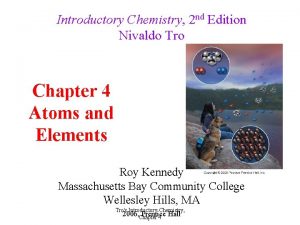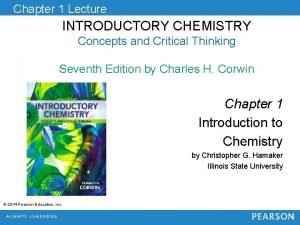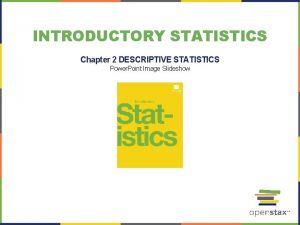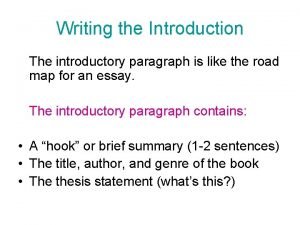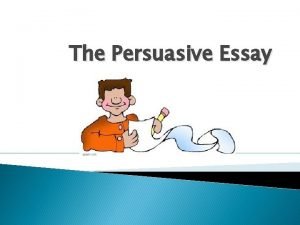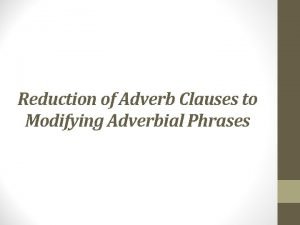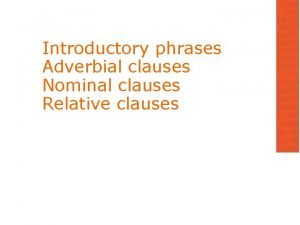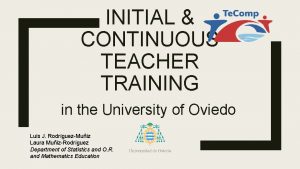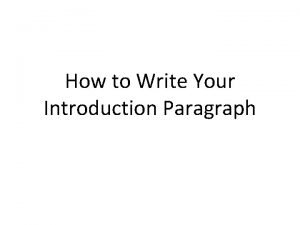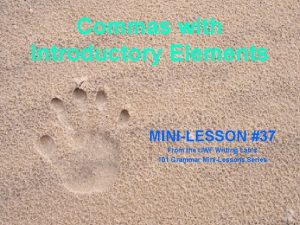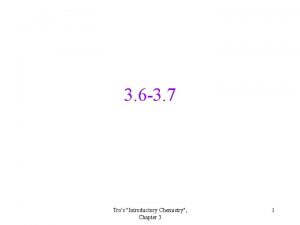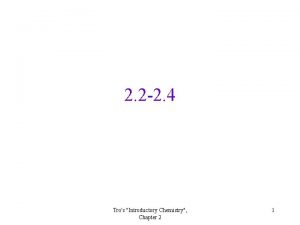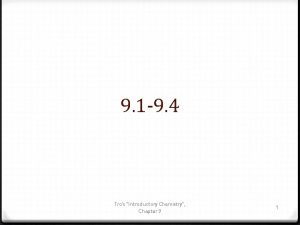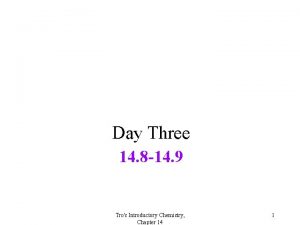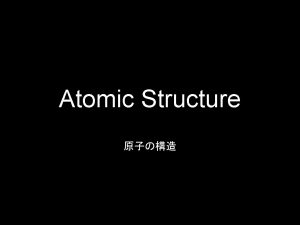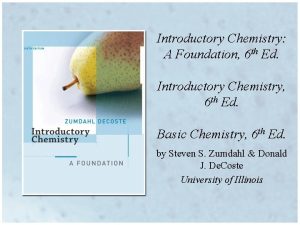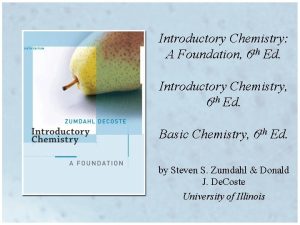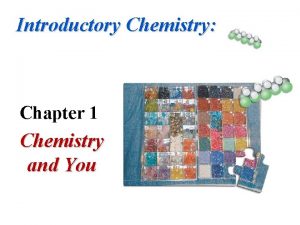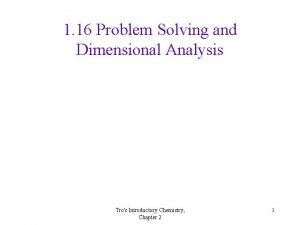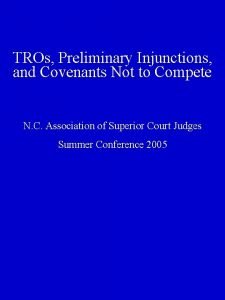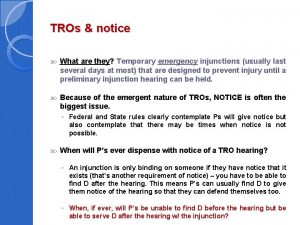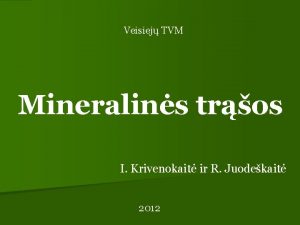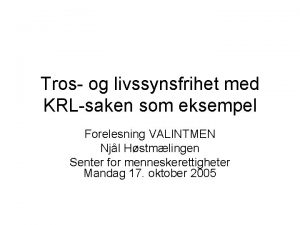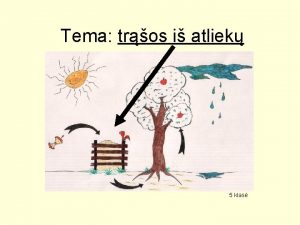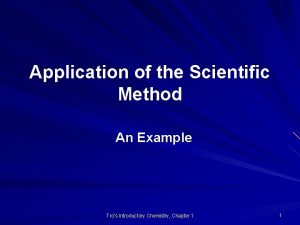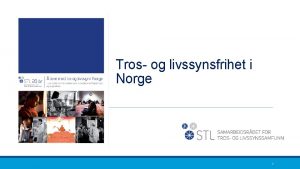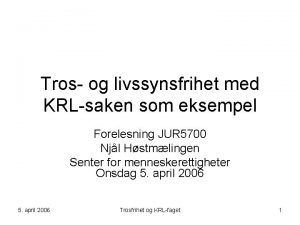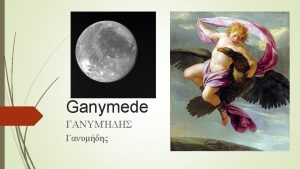3 2 3 6 Tros Introductory Chemistry Chapter























- Slides: 23

3. 2 -3. 6 Tro's "Introductory Chemistry", Chapter 3 1

What Is Matter? • Matter is defined as anything that occupies space and has mass. • Matter is composed of tiny atoms and molecules Tro's "Introductory Chemistry", Chapter 3 2

Atoms and Molecules • Atoms are the tiny particles that make up all matter. • In most substances, the atoms are joined together in units called molecules. üThe atoms are joined in specific geometric arrangements. Tro's "Introductory Chemistry", Chapter 3 3

Structure Determines Properties • The properties of matter are determined by the atoms and molecules that compose it. 1. 2. 3. 4. Carbon Monoxide Composed of one carbon atom and one oxygen atom. Colorless, odorless gas. Burns with a blue flame. Binds to hemoglobin. 1. 2. 3. 4. Carbon Dioxide Composed of one carbon atom and two oxygen atoms. Colorless, odorless gas. Incombustible. Does not bind to hemoglobin. 4

Classifying Matter by Physical State • Matter can be classified as solid, liquid, or gas based on what properties it exhibits. • Fixed = Property doesn’t change when placed in a container. • Indefinite = Takes the property of the container. Tro's "Introductory Chemistry", Chapter 3 5

Classifying Matter by Composition • Matter that is composed of only one kind of atom or molecule is called a pure substance. • Matter that is composed of different kinds of atoms or molecules is called a mixture. Tro's "Introductory Chemistry", Chapter 3 6

Classification of Matter Pure Substance Constant Composition Homogeneous Mixture Variable Composition • Pure Substance = All samples are made of the same pieces in the same percentages. ü Salt • Mixtures = Different samples may have the same pieces in different percentages. ü Salt water Tro's "Introductory Chemistry", Chapter 3 7

Pure Substances vs. Mixtures 1. 2. 3. 4. 5. Pure Substances All samples have the same physical and chemical properties. Constant composition = All samples have the same pieces in the same percentages. Homogeneous. Separate into components based on chemical properties. Temperature stays constant while melting or boiling. 1. 2. 3. 4. 5. Mixtures Different samples may show different properties. Variable composition = Samples made with the same pure substances may have different percentages. Homogeneous or heterogeneous. Separate into components based on physical properties. Temperature usually changes while melting or boiling because composition changes. Tro's "Introductory Chemistry", Chapter 3 8

Classification of Pure Substances • Substances that cannot be broken down into simpler substances by chemical reactions are called elements. ü Basic building blocks of matter. ü Composed of single type of atom. Ø Although those atoms may or may not be combined into molecules. • Substances that can be decomposed are called compounds. ü Chemical combinations of elements. Ø Although properties of the compound are unrelated to the properties of the elements in it! ü Composed of molecules that contain two or more different kinds of atoms. ü All molecules of a compound are identical, so all samples of a compound behave the same way. Tro's "Introductory Chemistry", Chapter 3 9

• Atoms and Molecules ü Are submicroscopic particles that are the unit pieces of elements. ü Are the fundamental building blocks of all matter. • Molecules ü Are submicroscopic particles that are the unit pieces of compounds. ü Two or more atoms attached together. Ø Attachments are called bonds. Ø Attachments come in different strengths. ü Molecules come in different shapes and patterns. Tro's "Introductory Chemistry", Chapter 3 10

Classification of Pure Substances Elements Compounds 1. Made of one type of atom. (Some elements are found as multi-atom molecules in nature. ) 2. Combine together to make compounds. 1. Made of one type of molecule, or array of ions. 2. Molecules contain 2 or more different kinds of atoms. Tro's "Introductory Chemistry", Chapter 3 11

Classification of Mixtures • Mixtures are generally classified based on their uniformity. • Mixtures that are uniform throughout are called homogeneous. üAlso known as solutions. üMixing is on the molecular level. • Mixtures that have regions with different characteristics are called heterogeneous. Tro's "Introductory Chemistry", Chapter 3 12

Classification of Mixtures, Continued Heterogeneous Homogeneous 1. Made of multiple substances, whose presence can be seen. 2. Portions of a sample have different composition and properties. 1. Made of multiple substances, but appears to be one substance. 2. All portions of a sample have the same composition and properties. Tro's "Introductory Chemistry", Chapter 3 13

Classifying Matter 14

Properties Distinguish Matter • Each sample of matter is distinguished by its characteristics. • The characteristics of a substance are called its properties. • Some properties of matter can be observed directly. • Other properties of matter are observed when it changes its composition. Tro's "Introductory Chemistry", Chapter 3 15

Properties of Matter • Physical Properties are the characteristics of matter that can be changed without changing its composition. ü Characteristics that are directly observable. • Chemical Properties are the characteristics that determine how the composition of matter changes as a result of contact with other matter or the influence of energy. ü Characteristics that describe the behavior of matter. Tro's "Introductory Chemistry", Chapter 3 16

Some Physical Properties Tro's "Introductory Chemistry", Chapter 3 17

Some Chemical Properties Tro's "Introductory Chemistry", Chapter 3 18

Changes in Matter • Changes that alter the state or appearance of the matter without altering the composition are called physical changes. • Changes that alter the composition of the matter are called chemical changes. üDuring the chemical change, the atoms that are present rearrange into new molecules, but all of the original atoms are still present. Tro's "Introductory Chemistry", Chapter 3 19

Changes in Matter, Continued • Physical Changes—Changes in the properties of matter that do not effect its composition. üHeating water. üEvaporating butane from a lighter. üDissolving sugar in water. Tro's "Introductory Chemistry", Chapter 3 20

Changes in Matter, Continued • Chemical Changes involve a change in the properties of matter that change its composition. ü A chemical reaction. ü Burning results in butane from a lighter to be changed into carbon dioxide and water. ü Silver combines with sulfur in the air to make tarnish. Tro's "Introductory Chemistry", Chapter 3 21

Is it a Physical or Chemical Change? • A physical change results in a different form of the same substance. • A chemical change results in one or more completely new substances. ü Also called chemical reactions. ü The new substances have different molecules than the original substances. Tro's "Introductory Chemistry", Chapter 3 22

Phase Changes Are Physical Changes • • Boiling = liquid to gas. Melting = solid to liquid. Subliming = solid to gas. Freezing = liquid to solid. Condensing = gas to liquid. Deposition = gas to solid. State changes require heating or cooling the substance. ü Evaporation is not a simple phase change, it is a solution process. Tro's "Introductory Chemistry", Chapter 3 23
 Introductory chemistry 4th edition
Introductory chemistry 4th edition Introductory chemistry 5th edition nivaldo j. tro
Introductory chemistry 5th edition nivaldo j. tro Introductory chemistry 5th edition answers
Introductory chemistry 5th edition answers Nivaldo j. tro introductory chemistry
Nivaldo j. tro introductory chemistry Introductory chemistry concepts and critical thinking
Introductory chemistry concepts and critical thinking Chapter 2 descriptive statistics answer key
Chapter 2 descriptive statistics answer key Ib organic chemistry functional groups
Ib organic chemistry functional groups Organic vs inorganic chemistry
Organic vs inorganic chemistry Purpose of introduction
Purpose of introduction Must not sentences examples
Must not sentences examples Variables and expressions 1-1 answer key
Variables and expressions 1-1 answer key Keeping your hands clean and dry persuasive essay
Keeping your hands clean and dry persuasive essay News story example
News story example Hook paragraph
Hook paragraph A paragraph on desert
A paragraph on desert Reduced adverbial clauses
Reduced adverbial clauses Atlas ti 7
Atlas ti 7 Introductory paragraph format
Introductory paragraph format Introductory adverbial phrase
Introductory adverbial phrase The main character of the necklace
The main character of the necklace Introductory maxqda course
Introductory maxqda course Model introduction paragraph
Model introduction paragraph What is a introductory element
What is a introductory element Army traffic safety training program
Army traffic safety training program



